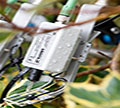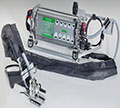WALZ
A MICRO-PAM system involves several light-weight chlorophyll fluorometers for field use. Being capable of multi-site monitoring of photosynthesis over weeks and months, the MICRO-PAM is tailored to study plant responses to environmental changes in nature and under controlled conditions. Due to its compact measuring heads, the MICRO-PAM is suited for smaller samples than those typically probed by the established MONITORING-PAM.

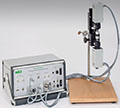
The DUAL-KLAS-NIR represents a significant advancement over the well-established DUAL-PAM-100 system. The DUAL-PAM-100 employs one pair of wavelengths in the near infrared (NIR) to measure absorption changes related to redox alterations of the photosystem I reaction center. Using four wavelength pairs in the NIR, the DUAL-KLAS-NIR is capable of unequivocally discriminating redox changes of plastocyanin (PC), PS I reaction center (P700) and ferredoxin (Fd).

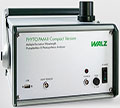
PHYTO-PAM instruments facilitate measurements of mixed algae populations for analysis of chlorophyll content and photosynthetic performance of variously pigmented phytoplankton. Deconvolution of the fluorescence responses of these phytoplankton groups is based on differences upon excitation with multiple excitation wavelengths. In contrast to the MULTI-COLOR-PAM fluorometer, where one of five colors can be applied at the time, with PHYTO-PAM devices different excitation wavelengths are applied quasi-simultaneously in form of µsec measuring light pulses with rapidly alternating colors.

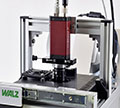
The IMAGING-PAM family comprises the versions MAXI, MINI and MICROSCOPY. The different versions employ the same Multi Control Unit IMAG-CG. Also, the same camera can be used for different versions. This modularity permits easy and most cost-effective switching between various applications and magnifications provided by the IMAGING-PAM M-Series. The MAXI and MINI versions can be combined with the Gas-Exchange System GFS-3000 and, thus, integrates detailed spatial information on photosynthesis with exact analysis of photosynthetic carbon fixation.

The DIVING-PAM-II is the successor of the DIVING-PAM which has been proven as reliable and robust chlorophyll fluorometer for studying photosynthesis in and under water. To date, about 500 scientific papers containing measurements with DIVING-PAM have been published. The DIVING-PAM-II continues the manifold tested design of its predeccessor, but it possesses significantly advanced data aquisition and instrument control by employing state-of-the-art optical and electronic components.

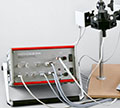
The MULTI-COLOR-PAM fluorometer provides an unprecedented color range of measuring and actinic light including white and far-red light sources. The various colors enable researchers to tailor conditions of fluorescence measurements exactly to the spectral properties of their sample. Therefore, the MULTI-COLOR-PAM fluorometer opens the way to study many wavelength-dependent aspects of photosynthesis that so-far have not been commonly accessible.

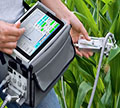
The PAM-2500 chlorophyll fluorometers are successors of the well-known PAM-2000/2100 instruments which were introduced in the 1990s as the first portable PAM fluorometers. Since then they have been successfully applied worldwide by numerous scientists. In the development of the PAM-2500, particular care was taken to maintain all properties appreciated by PAM-2000/2100 users and, at the same time, to integrate state-of-the-art technology.

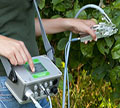
The new MINI-PAM-II fluorometer combines the merits of its predecessor “MINI-PAM” with most modern LED and computer technology. Sensitivity, small dimensions, reliability under rugged conditions, and simple execution of fluorescence analysis makes the MINI-PAM-II the new standard for PAM fluorometry in field research.

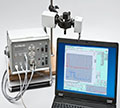
The DUAL-PAM-100 measuring system lifts the parallel recording of photosystem II and photosystem I activities on a new level. The outstanding opto-electronical properties of the DUAL-PAM-100 result from more than 25 years of experience with the PAM-101/102/103 chlorophyll fluorometer combined with exceptional modern engineering and craftsmanship.

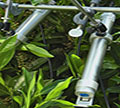
The chlorophyll fluorometer MONITORING-PAM is designed for unattended, long-term and multi-site monitoring of chlorophyll fluorescence in air or underwater. At each measuring site, compact and robust emitter-detector units measure modulated chlorophyll fluorescence and perform saturation pulse analysis.

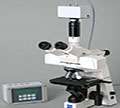
The MICROSCOPY-PAM is an extremely sensitive non-imaging chlorophyll fluorometer specialized to measure smallest spots in microscopic specimen like tissue preparations or suspensions. Essentially, the fluorometer consists of a modified epi-fluorescence microscope equipped with a modulated LED light source and a photomultiplier for detection of modulated chlorophyll fluorescence.

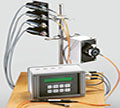
The MICROFIBER-PAM employs a very thin optical fiber for fluorescence excitation and detection. This narrow fiber permits probing of small spots of heterogeneous photosynthetic surfaces like soil crusts. Also, placing the microfiber at different penetration depths permits measurements of photosynthetic gradients within microbial mats and leaves.

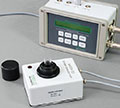
The WATER-PAM is the PAM fluorometer of choice when very low chlorophyll contents of samples require outstandingly sensitive fluorescence detection. The three different types of the WATER-PAM are designed to analyze suspension samples, surfaces, or a continuous water flow, respectively. The parameters measures are chlorophyll content and photosynthetic activity. All WATER-PAM chlorophyll fluorometers can be operated in the stand-alone mode which facilitates measurements in the field.

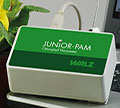
Pulse-amplitude modulated (PAM) chlorophyll fluorometry in combination with saturating pulse analysis of fluorescence quenching is now a standard technique to assess plant photosynthesis. In the 1990s, the Walz Teaching-PAM fluorometer (PAM-200) carried PAM fluorometry into university classrooms. Since then, there has been considerable progress in LED and PC technology, enabling the development of a powerful and versatile, and at the same time compact teaching fluorometer: the JUNIOR-PAM.

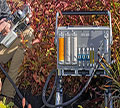
Gas exchange measurements rely on the basic principle that changes in CO2 and H2O concentrations are determined when air passes through a climate controlled chamber containing a plant sample. The GFS-3000 is suitable for controlled laboratory settings as well as demanding field conditions. The GFS-3000 perfectly complements with other Walz systems giving access to numerous aspects of photosynthesis research.

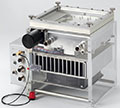
he Gas-Exchange Chamber 3010-GWK1 is designed to investigate medium-sized samples like small branches, big leaves, or fruits under well-defined climate controlled conditions. To provide this, the 3010-GWK1 chamber has a highly efficient temperature control, a transversal fan for fast ventilation, and pneumatic connectors for air-supply. Internally there are sensors to accurately monitor temperature at three sites, air humidity, and PAR (photosynthetically active radiation). Externally the chamber has additional sensors for temperature and PAR.

